The terms "gain equalization" and "gain flattening" come from the fiberoptic telecommunications field, where erbium-doped fibers are used to amplify the light traveling through the fiber. These amplifiers have a wavelength-dependent gain; i.e., some wavelengths are amplified more than others. A gain-flattening filter restores all wavelengths to approximately the same intensity. Erbium-doped fiber amplifiers (EDFA) operate in the 1530-1565 nm wavelength range.
' a- c6 H3 @+ D8 [' uThis type of filter has many applications. For example, for visible wavelengths 380-780 nm, a filter could be constructed to convert any continuous-spectrum illuminant into white light; e.g., light from an ordinary light bulb could be filtered to produce almost pure white light. " ~" s; x9 P) J+ ?9 p8 @$ P
An introduction of the design of this filter can be found in the paper " q/ m1 Y0 W, ^# Q9 y, b* n V
M. Tilsch, C.A. Hulse, K.D. Hendrix, R.B. Sargent, "Design and demonstration of a thin-film based gain equalization filter for C-band EDFAs", presented at the 1999 NFOEC conference.
8 D, M; ]! {7 d) J+ }+ f" I5 E. sThe plot below shows the relative intensity of the EDFA output. If this were plotted on the logarithmic dB scale, the output would have a range of 8 dB. & V0 u6 C. ~5 V, K3 q& K+ Y( x& [( B
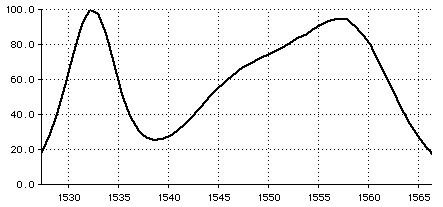 / F& @- d* [; H3 e / F& @- d* [; H3 e
We will use TFCalc's optimization capabilities to design a gain-flattening reflection filter which will flatten (or equalize) the output of the EDFA so that it is flat with a tolerance of ±0.5 dB. In general, the tolerance is tighter for real filters. 3 e* F3 x' g8 w) g- L; e
TFCalc has the capability of optimizing the product of the illuminant (EDFA) and the reflectance (or transmittance) of a coating. We want this product, which is the actual output of the filter, to be a flat as possible. As can be seen from the plot shown above, even if the filter reflects (or transmits) a 100% at the endpoints (1527.3 and 1566.3 nm), the output would only be about 20%. Hence, for the entire wavelength range, the flattened output of the filtered EDFA can be no more than 20%. The design becomes somewhat easier if the target output is less than 20%.
4 _6 R( @8 m$ C! w1 @Reflection Filter5 r4 d# U0 F. F
Tilsch et al studied the reflection filter in their paper. To design such a filter, we started with the initial 100-layer design (HL)^50, where H represents 1.2 QWOT of index 2.25 and L represents 1.2 QWOT of index 1.45. The reference wavelength is 1530 nm. The substrate has index 1.44. We design this for normal incidence; in reality, the filter will be positioned at a small angle. For the optimization target we use ) B7 N2 y" @8 V* }5 q
EDFA * Reflectance = 17.5% for wavelengths from 1527.3 to 1566.3
* s# j) i S$ q) z( _2 z5 U$ MA total of 201 equally-spaced targets are used. To make the output as flat as possible, we use power=16 during optimization. The result is a 91-layer design. In white light, the performance of the filter is shown below. % A/ c/ N! S! B* J0 e4 }8 h
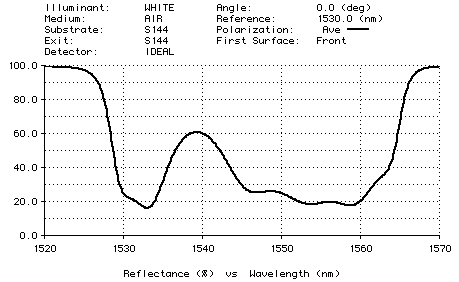 # V3 N* ^# d ] # V3 N* ^# d ]
The plot below shows the output of the filtered EDFA. If this is plotted on a dB scale, it becomes apparent that the design, if it could be produced without errors, meets the ±0.5 dB requirement. ; `' ?" N% `$ W ^2 z4 {
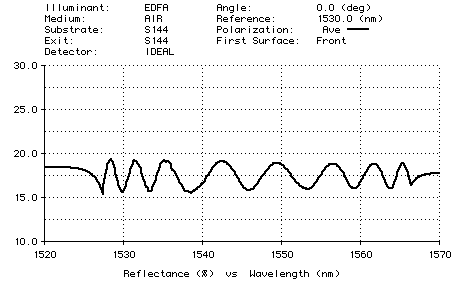 4 B; A3 g a$ n 4 B; A3 g a$ n
7 j# Z" L+ Y: X p$ T# HTransmission Filter; l( I- y! w+ K: b$ h5 o
To discover whether there is any advantage in using a transmission filter, we decided to design one. Most of the details are the same as for the reflection filter. However, this time we started with the 101-layer design (HL)^50 H. The target is
1 s0 k: o7 ~) REDFA * Transmittance = 17.5% for wavelengths from 1527.3 to 1566.3
) F0 {( v6 D+ s, s: E5 X0 W* oWe used one continuous target. Again, we use power=16. By constraining the layer thicknesses to be greater than 0.5 QWOT during optimization, we discover a 101-layer design having a very flat (less than ±0.12 dB) output, as displayed below on a dB scale.
! N& Z7 r1 {0 K& E7 ?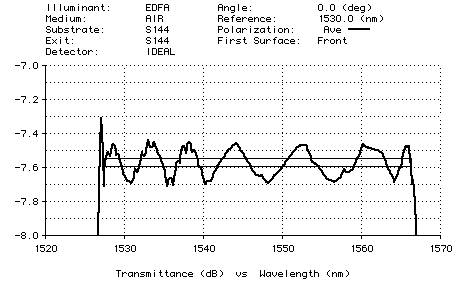
4 F# S8 {9 _+ _- E7 i3 R" k+ W
% t4 J% F. W4 i& G( Q" [0 LManufacturability
: S; @5 i- E8 o! \' Z* yBy randomly varying the thickness of layers, TFCalc can determine the manufacturability of a design. For the designs mentioned in the Tilsch et al paper, a maximum error of 0.05% is required for production. Note that, using this error limit, if a layer is 100 nm thick, then the thickness must be monitored to within ±0.5 angstrom! The plot below shows the range of the performance of the reflection filter for 1000 random designs when layers are allowed to vary uniformly by ±0.05%.
, l* k6 `0 v+ G: G8 G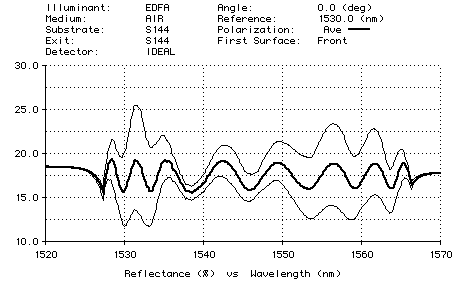 * c! h$ k3 y( D, g& Q: z * c! h$ k3 y( D, g& Q: z
Even 0.05% seems barely acceptable. Using TFCalc's sensitivity optimization capability, we can try to find a design that is less sensitive to manufacturing errors. The procedure is rather slow, but the results may be worth the wait. We chose to optimize the sensitivity of 1000 random designs. On a 1 GHz Pentium, this requires several hours. Below is the sensitivity analysis of the improved design. Note that the optimizer has found a design that is significantly less sensitive to thickness errors. # R: c% R7 e5 b5 `! _
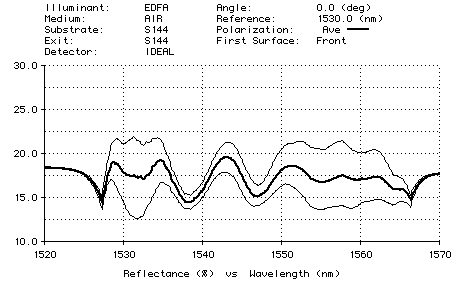
$ y( i; o7 h9 w& B2 }* D Although the sensitivity optimization seems to work by making the performance of the filter flatter when the intensity of the EDFA is high, the optimizer actually does more. Numerical experiments show that, in general, merely designing a filter that is flatter where the EDFA intensity is high will still be very sensitive to thickness variations. The sensitivity optimization actual finds a less sensitive design, which also happens to have a flatter output at wavelengths where the EDFA has higher intensity.
$ Z) m: Q+ w4 e3 {This work is not nearly as exhaustive as in the Tilsch et al paper. However, it does show how optimizing the sensitivity can improve the performance of a design. ) S$ ?, l0 X' K
Here are the two designs; Design 1 is the original reflection design; Design 2 is the reflection design optimized for sensitivity. The first layer is closest to the substrate and thickness is given in nm:
[/ { K; }; p& v U' xMaterial Design1 Design2% u) O* y5 R- ?* Y8 J
N225 173.22 183.23
* A& ]% d- b$ r; I& K+ x5 SN145 266.11 283.45
. j/ ~0 j L( e) j3 XN225 170.37 187.68! g7 ~" Z! Y3 K5 p
N145 281.70 310.91
% C H& G* X9 z4 x. u1 ]N225 241.67 232.70
8 s Y) i( l2 k. X3 c5 ~N145 499.80 486.55$ v2 a8 s. c) c9 W. E+ D, D9 r
N225 149.42 123.93+ w" |. Y+ r9 Q7 u' O& q
N145 216.86 239.55
, {: T; I$ |2 T( N6 YN225 170.23 182.06) r0 s6 [& L6 a/ T s" `( _
N145 276.29 300.51: v: z; z0 F6 f3 x2 l: k7 Y n
N225 162.25 185.72
2 {- l$ Z) k% PN145 260.42 264.953 _4 w7 n# V- s
N225 176.10 151.72
5 K9 F, p% D8 r* Z+ {N145 249.71 215.61
' ?. c: k: c0 V/ l# s! t( p4 m7 RN225 389.76 404.62
% _- k! ]* k( `) u; S" @N145 244.24 250.29) X' }/ C( I" Q2 i
N225 176.51 176.04" p Y. [$ Z* Z3 g! k
N145 269.84 258.26
5 l8 Z8 H9 ?+ H( q1 d9 D# r/ c2 sN225 172.68 161.16 x9 [9 j9 K$ ?
N145 351.00 358.60
' U5 L# F, Z. y, Q1 R0 s/ u, KN225 318.17 316.63+ R. H# }9 ~4 |' ~2 d& Z: F& a
N145 285.93 279.08$ A8 o Z- C3 `* ?' O# f' R0 u. n
N225 158.51 181.70+ C6 Y$ R3 _+ |+ E. S. Y
N145 246.70 282.89
1 \$ t$ Y" v+ BN225 177.51 169.199 |* O u5 Z9 z% y
N145 290.04 253.960 K9 B" k; m1 Y
N225 166.26 165.89" x: W! I% H, t: s* h
N145 265.69 263.71 t/ B" H( s& _
N225 187.39 176.44
$ q+ C4 e& M3 _0 X/ u2 |N145 311.12 322.47. [; i; Q) F' K* P, _6 Y' q" {( k* l
N225 266.31 283.07
9 s/ ^% { t# p! U$ ~N145 353.44 322.819 s2 r1 q0 c0 g8 _: [9 F0 g
N225 183.75 179.50
: `! P: v( {# N2 {% KN145 268.79 273.76
" X I8 k. K! v9 V( Y- JN225 177.71 179.47
% `. }4 L4 v- k- ?2 EN145 267.34 275.20
6 B! I+ R/ j! p$ b( K3 |) ZN225 180.82 186.31
! @' m% g& j$ i3 P4 |* p& z" KN145 265.61 285.18
# ^+ I) r: L$ S6 T# ^9 LN225 179.56 191.58
0 J5 m' b0 ]( H$ ?) c- QN145 310.69 307.51
3 F4 X' \4 r: V gN225 201.44 191.85! _# j9 m* [' I; w5 w% b' `
N145 337.80 335.97* V1 E% V* s# K0 k5 J' ?9 V' \2 `
N225 546.46 539.711 C$ ?* D6 Q3 C! {; {- \
N145 419.51 418.70 I+ m2 f2 `3 W% T
N225 180.85 182.18. y, C( E' }* S1 {( A4 W9 u
N145 261.04 270.87
7 x+ T* }' A3 bN225 173.18 179.082 u3 H0 ]) `, E+ q! Y
N145 264.37 276.37- H2 ]# X a8 P% @
N225 172.93 185.79( l1 {: d* A) `. m9 `: z
N145 264.15 256.11
6 {* d/ _1 k: s) o% FN225 175.67 168.30
5 E2 \9 w, W/ y9 HN145 265.07 260.12
8 ?4 v3 F& l! D' ?' S; ~* Z2 J: NN225 178.47 199.99: E% b0 M# A( Y- f5 _
N145 251.01 244.436 [ a: Q7 }2 j2 ^: ^5 {
N225 182.79 199.31
0 `4 v: o3 t8 m' ^- k+ fN145 596.29 582.84
6 x% }* `: {/ l" y4 J- v s5 {- \6 p6 {N225 115.52 114.771 }6 k+ v6 U4 l, C2 ]4 \" m4 l# s/ r
N145 244.92 217.380 c$ F6 _- ] |( x% _; W/ q: U
N225 173.55 177.198 `/ M6 Q2 m% g$ C/ \8 C: ?
N145 263.13 271.27
|! G7 o! N) Q: p2 @* X- U& ]N225 168.53 174.83& d! s6 u$ ]! F U6 h
N145 265.62 276.17
4 F! x: v' Z' ]1 w" u& j0 tN225 172.31 179.17- q/ P* \# ^# i
N145 264.86 274.155 l/ M, x# j w/ q9 j. ^8 U
N225 175.52 180.52
' i- Q$ M. V2 BN145 280.45 288.85' y: O+ N( m# N" W' H
N225 176.08 183.83" h# b; _. c9 x d5 ^( J
N145 243.23 239.703 p* ^/ p. x& e) c% C" @7 N9 D6 O: D
N225 245.25 215.08
8 e) u3 I% B L3 GN145 177.49 231.26& B& D( A3 A1 L6 B
N225 358.93 358.44% b- Z- ]: g# _; K/ y7 \/ {3 F
N145 262.76 255.62
. Y+ C# B4 A" Q, j- f0 F! d7 EN225 176.24 171.928 L+ m! O& h! @) t
N145 245.65 223.47
8 d6 X7 q) V6 r# ?; ~) y; }N225 166.69 160.65
- Q( B+ `# v( ^- F" U6 ^N145 255.30 259.85
! Q& @: V6 v9 e5 d- c: s0 gN225 165.34 169.67$ ?# r3 b+ Z3 F- l$ o3 z5 m' v- n% v
N145 256.16 275.05! i( H, ~/ Q! T; f J6 l
N225 412.72 403.73. }0 h5 X1 B. y( E8 F
N145 239.67 218.932 U: K& b( [" O2 u) a" K0 X: d
N225 175.49 175.58) G2 N3 o) k5 m4 }# p
N145 273.85 297.29
' Y% b) B Y% z q& eN225 140.82 169.588 `/ J. N' `! }8 `" l% ?: d( Q" v7 p! @
N145 297.28 309.527 a% K9 A" r0 t: D8 ~$ f4 ^
N225 219.98 193.75
0 U) U/ g) q" E1 L2 x9 BN145 493.44 484.74
- a5 P) U& D( M8 YN225 168.57 157.29
% _, W0 _0 k% n" e, o! _# @N145 282.43 319.13
+ P8 y+ ~. `9 s# YN225 175.48 186.11! O5 u4 t G; b; N+ l
N145 274.12 303.92* x' S+ y0 s* T& L! j4 A
N225 173.02 181.17 |
